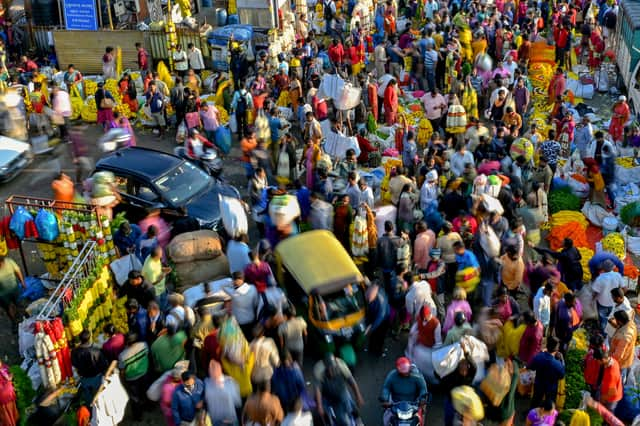India population: will country overtake China in 2023, world population - what does it mean for global economy


India is on track to surpass China as the world's most populous country by mid-2023, according to data made public by the UN.
By the middle of the year, the South Asian nation will have 1.4286 billion people compared to China's 1.4257 billion - a difference of 2.9 million people - according to UN estimates. China has had the world’s largest population since at least 1950, the year United Nations population data began.
Advertisement
Hide AdAdvertisement
Hide AdBoth China and India have more than 1.4 billion people, and their combined populations account for more than a third of the eight billion people on the planet. Here is everything you need to know about it.
What has brought about the change?
India wasn't expected to overtake China as the world's most populous country until later this decade. But because China's fertility rate has decreased and families are having fewer children, this has changed.
Despite the government abandoning its one-child policy seven years ago, China now has an ageing population with stagnant growth. In contrast, India has a younger population and a higher fertility rate. Infant mortality has also decreased over the past 30 years.
However, according to data from the World Bank, the nation's fertility rate has been steadily declining, going from over five births per woman in 1960 to just over two in 2020.
Loading....
What does it mean for the world?
Advertisement
Hide AdAdvertisement
Hide AdIndia’s continued growth is likely to have widespread social and economic consequences felt around the world. According to the UN, India has 254 million young people between the ages of 15 and 24, and experts hope this means an expanding labour force that will support future economic growth in the nation.
A growing population can lead to increased consumption and production, leading to economic growth and greater demand for goods and services, which in turn can create new jobs and opportunities for businesses. This can boost the overall standard of living and help to reduce poverty levels.
However, they caution that if India's rapidly expanding young population is not given adequate employment opportunities, it could just as quickly turn into a demographic liability.
In order to move production out of China, where wages are rising as the country's population of people of working age is declining, businesses like tech giant Apple are hoping to turn India into a potential manufacturing hub.
Advertisement
Hide AdAdvertisement
Hide AdThe hope is that India’s soaring number of working age people will give it a “demographic dividend”, or the potential for economic growth when a country’s young, working age population is larger than its share of older people who are beyond their working years.
That is what helped China become an economic and global heavyweight, even as its number of working age adults is now falling.
What does it mean for India?
Closer to home, 63% of Indians said economic issues were their top concern when thinking about population change, followed by worries about the environment, health and human rights.
One major issue that can arise from a rapidly expanding population is the strain it can place on resources and infrastructure, such as housing, healthcare, and education. This can lead to overcrowding, inadequate access to services, and increased competition for resources, which can exacerbate inequalities and social tensions.
Advertisement
Hide AdAdvertisement
Hide AdRapid population growth can also have a significant impact on the environment, with increased demand for food, water, and energy leading to deforestation, soil erosion, and other forms of environmental degradation. This can have serious consequences for biodiversity, ecosystem services and human health.
Andrea Wojnar, the United Nations Population Fund’s representative for India, said of the report: “The Indian survey findings suggest that population anxieties have seeped into large portions of the general public. Yet, population numbers should not trigger anxiety or create alarm.” She added that they should be seen as a symbol of progress and development “if individual rights and choices are being upheld”.
There are concerns that rapid population growth can undermine efforts to promote human rights, including access to education, healthcare and reproductive rights. Women and marginalised groups may be particularly affected, as they may face greater barriers to accessing services and resources, leading to further inequalities and social exclusion.
Comment Guidelines
National World encourages reader discussion on our stories. User feedback, insights and back-and-forth exchanges add a rich layer of context to reporting. Please review our Community Guidelines before commenting.
